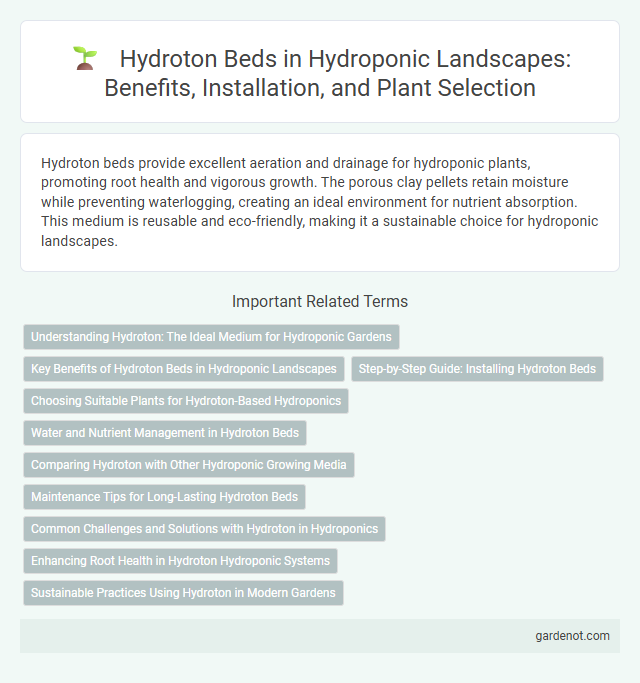Hydroton beds provide excellent aeration and drainage for hydroponic plants, promoting root health and vigorous growth. The porous clay pellets retain moisture while preventing waterlogging, creating an ideal environment for nutrient absorption. This medium is reusable and eco-friendly, making it a sustainable choice for hydroponic landscapes.
Understanding Hydroton: The Ideal Medium for Hydroponic Gardens
Hydroton, also known as expanded clay pellets, serves as an exceptional growing medium for hydroponic gardens due to its lightweight, porous structure that promotes excellent aeration and water retention. Its inert nature prevents nutrient imbalance, ensuring plants receive precise nourishment while minimizing root diseases. Hydroton's durability and pH neutrality contribute to a stable root environment, making it the ideal substrate for efficient and sustainable hydroponic cultivation.
Key Benefits of Hydroton Beds in Hydroponic Landscapes
Hydroton beds provide excellent aeration and drainage, promoting healthier root development in hydroponic landscapes. Their lightweight, porous structure retains moisture effectively while preventing waterlogging, ensuring optimal oxygen availability for plants. These benefits enhance nutrient uptake and support sustainable, high-yield growth in various hydroponic systems.
Step-by-Step Guide: Installing Hydroton Beds
Installing Hydroton beds begins with selecting a sturdy frame and ensuring proper drainage by layering a filter cloth at the base. Evenly spread Hydroton clay pebbles, which provide excellent aeration and moisture retention, to create an ideal medium for plant roots. Connect the irrigation system to maintain consistent nutrient delivery and verify water flow to prevent root drowning or drying.
Choosing Suitable Plants for Hydroton-Based Hydroponics
Selecting suitable plants for Hydroton-based hydroponics involves considering species that thrive in well-drained, oxygen-rich environments. Leafy greens like lettuce, spinach, and herbs such as basil and mint exhibit optimal growth due to Hydroton's excellent aeration and water retention properties. Fruit-bearing plants like strawberries and tomatoes also perform well when paired with Hydroton, as the clay pebbles support root stability while maintaining moisture balance.
Water and Nutrient Management in Hydroton Beds
Hydroton beds offer superior water and nutrient management by providing excellent aeration and drainage through their lightweight expanded clay pellets. These pellets facilitate uniform distribution of water and nutrients, preventing overwatering and nutrient leaching while promoting healthy root oxygenation. Efficient water retention combined with precise nutrient delivery in Hydroton beds supports optimal plant growth and sustainable hydroponic cultivation.
Comparing Hydroton with Other Hydroponic Growing Media
Hydroton, a lightweight expanded clay aggregate, offers superior aeration and drainage compared to traditional hydroponic growing media like coconut coir or rockwool. Its pH neutrality and reusable nature reduce nutrient imbalances and environmental waste, providing a sustainable advantage over absorbent media. The spherical shape of Hydroton particles creates consistent root oxygenation, promoting healthier plant growth and higher yields in hydroponic systems.
Maintenance Tips for Long-Lasting Hydroton Beds
Regularly rinsing Hydroton beds removes accumulated salts and debris that can hinder plant growth. Monitoring pH levels ensures the bed remains balanced, preventing nutrient lockout and promoting healthy roots. Periodic sterilization of Hydroton clay pebbles reduces harmful pathogens, extending the lifespan of the hydroponic system.
Common Challenges and Solutions with Hydroton in Hydroponics
Hydroton, a popular expanded clay aggregate in hydroponic landscapes, often faces challenges such as pH fluctuations and nutrient retention issues that impact plant growth. To stabilize pH levels, growers commonly pre-soak Hydroton in pH-balanced water and flush the system regularly to prevent salt buildup. Enhancing nutrient uptake can be achieved by combining Hydroton with organic nutrient solutions and employing proper aeration techniques to maintain optimal root oxygenation.
Enhancing Root Health in Hydroton Hydroponic Systems
Hydroton beds provide an oxygen-rich environment that promotes vigorous root growth and prevents root rot in hydroponic systems. The expanded clay pellets offer excellent drainage and aeration, maintaining optimal moisture levels essential for nutrient absorption. This balance significantly enhances root health, leading to stronger, more resilient plants in Hydroton hydroponic setups.
Sustainable Practices Using Hydroton in Modern Gardens
Hydroton, an expanded clay aggregate, supports sustainable practices in modern gardens by providing excellent aeration and water retention, reducing the need for frequent irrigation. Its reusable nature minimizes waste and promotes eco-friendly gardening, making it ideal for hydroponic systems that conserve water and nutrients. The lightweight, pH-neutral Hydroton also enhances root health while enabling efficient resource management in urban and commercial landscapes.
Hydroton bed Infographic

 gardenot.com
gardenot.com